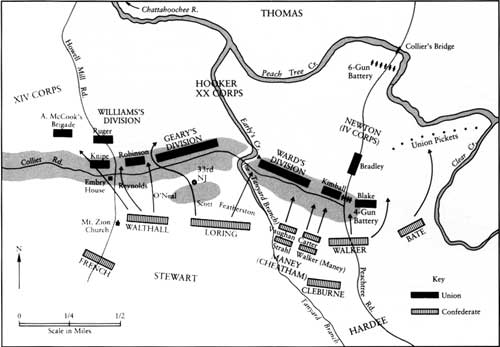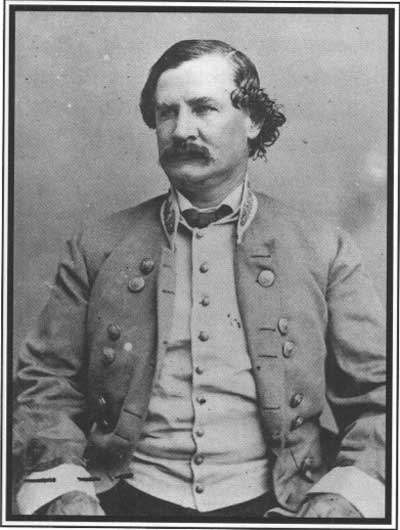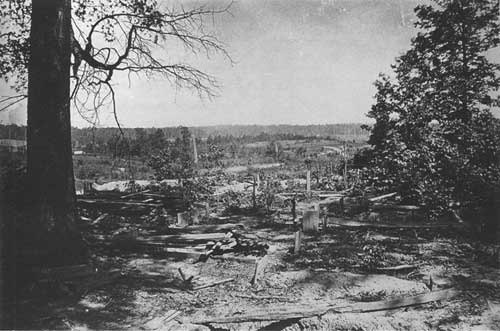|
BATTLE OF PEACHTREE CREEK
In becoming commander, Hood took on the task of stopping, or better
still defeating, Sherman. How was he to do it? On July 19 his cavalry
reported that McPherson and Schofield were moving toward Decatur, six
miles east of Atlanta, and that Thomas was beginning to cross Peachtree
Creek, five miles north of the city. Thus a wide gap existed between the
two wings of the Union army. Hood at once decided to exploit it. At a
late-night conference with his top generals he outlined a plan whereby,
come tomorrow, Wheeler and Major General Benjamin F. Cheatham, who now
headed Hood's former corps, would hold McPherson and Schofield in check
while Hardee's and Stewart's Corps, under the operational command of
Hardee, attacked Thomas's forces and drove them back to the banks of the
Chattahoochee and Peachtree Creek at the point where the latter flowed
into the former, trapping and destroying them. Then the following day
the whole Confederate army would fall upon and crush McPherson and
Schofield.

(click on image for a PDF version)
|
BATTLE OF PEACHTREE CREEK
Sherman's army advanced southward from the Chattahoochee in two
groups. One, consisting of McPherson's Army of the Tennessee and
Schofield's Army of the Ohio, marched to the Decatur area where it
severed the Georgia Railroad and then turned west toward Atlanta. The
other, Thomas's Army of the Cumberland (IV, XIV, and XX Corps), moved on
Atlanta directly from the north. Hood, perceiving the wide gap between
the Union forces, decided to exploit it. On the afternoon of July 20,
Hardee's and Stewart's Corps assailed Thomas south of Peachtree Creek.
Although the Confederates achieved some initial successes against the
surprised Federals, their attack failed owing to poor coordination and
inadequate strength.
|
If successful, this plan would result in the greatest victory of the
war. Unfortunately for the Confederates, it was based on the premise
that McPherson and Schofield were advancing toward Decatur when in fact
they were advancing from it and so were closer to Atlanta than Hood
thought. Consequently, late on the morning of July 20 Wheeler, whose
cavalry, fighting dismounted, opposed Mcpherson's advance along the
Decatur-Atlanta road, had to call for help from Cheatham on his left.
This caused Cheatham to shift to his right, which in turn obliged Hardee
and Stewart to slide rightward also, thereby delaying their attack,
which had been scheduled to begin at 1 P.M., by several hours.

|
MAJOR GENERAL BENJAMIN F. CHEATHAM
|
Yet Hardee's and Stewart's redeployment actually enhanced their
prospects of success, for it placed most of Hardee's Corps beyond
Thomas's left flank, which was held by Newton's division of the IV
Corps—that corps' other two divisions were with Schofield—and
put Stewart's Corps in position to assail the mainly unentrenched XX
Corps instead of the strongly fortified XIV Corps, whose commander,
General John Palmer, did not share the prevailing Union view that there
was little or no danger of a Rebel attack north of Atlanta. In short,
luck was with the Confederates; now all they needed was skill and
determination.
Both of these qualities were conspicuous for their absence in
Hardee's assault. Bate's Division on the right literally got lost in the
Peachtree Creek bottomlands and thus did not engage the enemy, at least
not seriously. In the center Major General W. H. T. Walker's Division
delivered a series of disjointed charges that Newton's troops, fighting
from behind hastily improvised breastworks, easily repelled. And on
Hardee's left Cheatham's Division, headed by Brigadier General George
Maney, either did not attack at all or else went to ground on beholding
Yankee trenches. With about 15,000 available troops, Hardee failed to
dislodge, much less overpower, Newton's 3,200 men.

|
ON-THE-SCENE SKETCH BY THEODORE H. DAVIS SHOWS GENERAL HOOKER'S POSITION
DURING THE BATTLE OP PEACHTREE CREEK ON JULY 20. (COURTESY OF AMERICAN
HERITAGE PRINT COLLECTION)
|
Stewart's attack, in contrast, was everything that Hardee's was not.
Delivered with great ferocity by Loring's and Major General Edward
Walthall's Divisions—Stewart had to hold back Major General Samuel
French's Division and two brigades to cover his left flank—it
nearly broke through the XX Corps, which was caught off guard and for
the most part undeployed and unfortified. Loring's and Walthall's four
brigades, however, simply lacked the strength to sustain their advances
against Hooker's nine brigades, which quickly rallied, and so they had
to retreat. Undaunted, Stewart called on Hardee to renew the attack.
Hardee concurred and ordered forward Cleburne's Division, hitherto held
in reserve. But before Cleburne's crack troops could charge, Hardee
received word from Hood that Wheeler urgently needed assistance,
whereupon he canceled their assault and sent them to the east side of
Atlanta. So ended the Battle of Peachtree Creek. In it Hood, who lost at
least 2,500 men, was foiled in his attempt to smash one-half of
Sherman's army as a prelude to doing the same to the other half. Yet
Sherman deserved no credit for the Union victory, which cost nearly
2,000 casualties, most of them in the XX Corps. Because he was east of
Atlanta, where he expected Hood to make a stand if he made one at all,
he did not even know the battle had taken place until he received at
midnight, six hours after it ended, a message from Thomas informing him
of it. Moreover, during the height of the fighting along Peachtree Creek
he sent an order to Thomas to occupy Atlanta, as there was no strong
enemy force to oppose him. Finally, he did nothing to push forward
McPherson, who, instead of sweeping aside Wheeler's cavalry with his
25,000 infantry, advanced with such cautious slowness on Atlanta that
nightfall found him still more than a mile from the city. It was a case
of Snake Creek Gap and Resaca all over again, and again Sherman must
share the responsibility with McPherson.

|
THIS PHOTOGRAPH TAKEN AFTER THE BATTLE OF PEACHTREE CREEK SHOWS THE
GRAVES OF SOME WHO PERISHED THERE. (USAMHI)
|
The failure to drive Thomas into the Chattahoochee disappointed but
did not discourage Hood: Sherman's army remained divided and hence
vulnerable. Learning that McPherson's left flank was
exposed—Sherman had sent off the cavalry that should have been
screening it to raid the railroad between Atlanta and Augusta,
Georgia—Hood on the night of July 21 sent Hardee's Corps and
Wheeler's cavalry swinging around that flank with orders to march to
Decatur, then in the morning to pounce on McPherson from the rear,
routing his forces and opening the way for Cheatham's troops to join
with Hardee's and Wheeler's in doing the same to the rest of the Union
army east of Atlanta. Meanwhile, Stewart. whose corps had fallen back to
the city's north-side fortifications, would hold Thomas in check.
|
|
